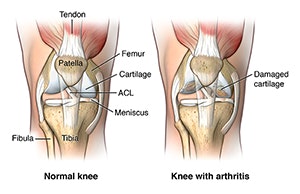How to Prevent Osteoarthritis

There are about 100 different types of arthritis. In general, arthritis means problems with the joints. A joint is a place in the body where 2 bones meet. Arthritis may also affect other body tissue near the joints including muscles, tendons, and ligaments. And, in some forms of arthritis, the whole body is involved.

Osteoarthritis (OA) is sometimes called degenerative joint disease or wear-and-tear arthritis. It is the most common type of arthritis. In OA, the cartilage wears away. Cartilage covers the ends of bones and acts as a cushion. If enough cartilage wears away, bone rubs against bone. The joint changes in OA cause pain, stiffness, and trouble with movement.
Can you prevent OA?
OA is called wear-and-tear arthritis because it is a result of using joints every day. The older a person gets, the greater the wear-and-tear. You can’t completely prevent OA. But there are things that you can do to help lessen every day stress on your joints and make it less likely that OA will happen, or get worse.
Maintain your ideal body weight
Extra weight puts stress on your joints, especially your hips, knees, ankles and feet. And extra fat actually causes changes in the cartilage cells. If you are overweight, talk with your healthcare provider about safe ways to lose weight.
Control blood sugar
High blood sugar levels raise your risk of getting OA.
Be active every day
Exercise is the best way to prevent joint problems. It helps to keep joints from getting stiff and keeps muscles strong. It’s also an important part of the treatment of arthritis. Try for at least 30 minutes of exercise on most days. Talk with your healthcare provider about safe exercise for you.
You can also try the Arthritis Foundation’s Walk With Ease program.
Avoid injury to joints
Joint injuries increase your risk of getting OA. When you exercise, start slowly and work up to your goal. Each time you exercise, take 5 to 10 minutes to warm up with gentle movements and stretches. This helps to prevent injuries to muscles, joints, ligaments, and tendons.
Think about changing your exercises and activities each day. You will use different parts of your body and help to avoid stressing the same joints every day.
Be careful with your daily activities. Some activities put stress on joints. For example, it is much safer to carry heavy bags of groceries close to your body in paper or cloth bags instead of using fingers and hands on plastic bag handles.
Use exercise equipment and protective gear as instructed. Make sure your safety gear is comfortable and fits well.
Pay attention to pain
If you have joint pain lasting 1 to 2 hours after activity or exercise, you may have done too much. Rest the joint. Try an ice pack to relieve pain.
Talk with your healthcare provider about using ice packs and pain medicine before and after you exercise.
Taking good care of yourself by keeping a healthy weight and exercising every day helps to prevent joint problems and helps you stay healthy.
Online Medical Reviewer: Finke, Amy, RN, BSN
Online Medical Reviewer: Horowitz, Diane, MD
Date Last Reviewed: 2/1/2017
© 2000-2018 The StayWell Company, LLC. 800 Township Line Road, Yardley, PA 19067. All rights reserved. This information is not intended as a substitute for professional medical care. Always follow your healthcare professional’s instructions.
